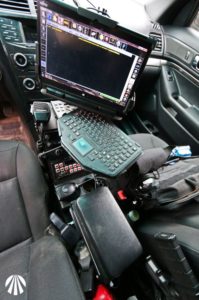Roadside Safety, Part 3: Officer Patrol Car Equipment
In case you missed it, you can read part I of our Roadside Safety series here.
Office. Workspace. Cubicle.
Whatever you want to call it, you don’t hear these words and think “danger,” do you?
For police officers, patrol vehicles are their mobile workspaces. Officers spend a ton of time per shift in their “traveling offices,” which are typically equipped with a computer, printer, phone and more, all crammed into one small space.
Simply by the nature of the job, a police officer patrol car is thrust in the middle of dangerous environments. Traffic issues, emergency responses, violent persons, hazardous substances, drugs, weapons, inclement weather, car accidents, fires, riots … a mobile office shouldn’t add to the operational hazards of police work.
In a job where danger is “expected,” unfortunately statistics involving motor vehicles and police officer fatalities speak for themselves. In 2019, as of March 29, there have been 11 transportation-related officer deaths, which accounts 39% of all line of duty deaths so far this year.
Purchasing and installing ANY equipment inside a police officer patrol car requires thought. Planning for safe securement and positioning, weight, sharp edges, proximity to airbags and equipment, and impact on driver visibility are frequently sacrificed in order to get the gear deployed quickly.
With this in mind, our Law Enforcement Support Team put together a list of recommendations and precautions for roadside and traffic safety.
Part of the LE Support Team’s job here at L-Tron is to be a voice for their colleagues in blue. They let us know the true pain points that departments are facing, shed light on what we can do to help officers, and make sure that our law enforcement equipment is not only useful, but SAFE.
Here are some key considerations when selecting the safest equipment and technology for the patrol vehicle.
The safest gear is…
- Securely mounted
During pursuits,a crash, or even routine operation, unsecured devices and equipment can result in serious injury. It comes down to physics. According to a study by the company Driving Dynamics, a 16-ounce water bottle striking someone in a 50 mph crash has the equivalent force of a 21-pound object. Loose objects can interfere with vehicle controls, become distractions and lead to crashes. Purchasing the proper mounting hardware, instead of budget solutions such as hook and loop fasteners, is key to safety.
- Proper proximity to other gear
Adding technology into the cabin of a patrol vehicle (typically not designed for it) can interfere with safety equipment such as seat belts, airbags, mirrors, seat adjusters, and fire extinguishers. Adding multiple devices over time may compromise original installations and may require relocating other technology. Consulting with car manufacturers and companies specializing in technology installations can enhance officer safety and the user experience.
- Planned positioning
The cabin of a patrol vehicle isn’t designed for office work, so locating technology for ease of use, ergonomics, and the best possible contributes to stress reduction for the police officer. Easily adjustable mounting hardware for tablets, laptops, mobile display terminals, printers, radios, and cell phones is key, particularly for agencies where more than one officer uses the same patrol unit. Positioning becomes critically important for driving — specifically visibility. While agencies, on paper, may require officers pull to the side of the road to operate technology, the reality is cops multi-task. A police officer must listen and respond to the radio, view and manipulate the computer, operate emergency equipment – all while driving.
- Easily accessible and easily stowed
Time is of the essence in law enforcement. Equipment should be readily accessible so an officer can use it roadside and get back on patrol quickly. If the officer is called away to an emergency in the middle of paperwork, equipment must be securely put back in place as quickly as possible.
- Efficient to use
There is no time to waste figuring out how to use the equipment in your patrol vehicle. Equipment and technology should be intuitive, require minimal training, and complete the task efficiently. More time spent on the curb means more time in harm’s way.
- Allows you to keep your eyes on your surroundings
Situational awareness is critical. When it comes time to pull over for paperwork, it can be easy to let your guard down, become hyper-focused on the administrative task at hand, and unintentionally put yourself in danger. Your survival mindset, choice of location, and position of patrol unit all play into situational awareness while completing paperwork.
But equally important, but often outside your control, is planning your mobile office. If you’re not included in the choice and planning of in-car technology, it’s in your best interest to get involved. In all likelihood, both planning and installation are done by people who will not be using your patrol unit.
It’s in the best interest of a police agency to have officers who actually use the patrol unit involved in planning. Technology choices and installation directly affect officers’ work environment and situational awareness.
L-Tron can help you select the safest, most reliable equipment for your patrol vehicles, including:
- Driver’s license readers and mounts
- Computers and mount/docking stations
- Software programs
- Mobile printers and paper
Thousands of municipalities in all 50 states have trusted us with their partnership. Call our law enforcement team today to talk safety, efficiency and more.

